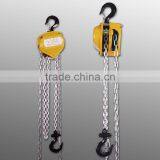Specifications
chain hoist1. capacity range: 0.5t ~ 10t
2. auto double pawl braking syetem
3. double cover protection
Features:
1. Capacity ranges from 0.5t to 10t.
2. Automatic double pawl braking system.
3. Double cover protection.
4. Light weight robust construction.
5. Low effort to lif maximum load.
6. Extra thick asbestos free friction discs.
7. Fully forged hooks are fitted with safety latches as standard.
8. ISO high grade alloy load chain.
9. Zinc plated hand chain as standard.
Specifications and Models:
Other Models available:
A lever hoist is a manual device used to lift, lower, or pull a load and to apply or release tension. It utilizes a ratchet and pawl mechanical configuration to incrementally raise or lower a load or to apply or release tension.
A chain hoist is a mechanical device used for lifting heavy loads of objects and equipment. It is made with a pulley, which is held together by a closed chain. The closed chain forms a loop, which makes it easy to be pulled by hand.
Inspection Before Use:
Ensure that the chain block name plate and WLL is clearly visible and legible.
The pre-use inspection for a chain block should include the following:
Load chain
- Inspect chain for wear.
- Inspect chain for gouges, nicks, arc burns, twisted & bent links and corrosion.
- Inspect for correct reeving on multi-reeved units (3 and 5 tonne).
Lift wheels & Sheave wheels
- Inspect lift wheel for foreign material, wear and corrosion.
- Inspect dead end pins for wear, tightness and corrosion.
Hooks
- Inspect hooks for signs of opening, cracking, bending, arc burns and corrosion.
- Hooks should swivel freely.
- Inspect safety latches for condition & operation.
- Measure the hook throats for allowable service openings.
Hand chain
- Inspect chain for wear.
- Inspect chain for twisted or gouged links and corrosion.
- Inspect connecting link for signs of opening.
Miscellaneous
- Inspect frame and covers for distortion, cracks, gouges, corrosion & other damage.
- Inspect hangers (3 and 5 tonne) for cracks, gouges, corrosion & other damage.
- Inspect unit for clear WLL identity.
Care In Use:
- The load chain must always mesh correctly with the load sheave. With multi fall chain blocks twists can arise by turning over the bottom hook through the load chain.
- Regularly lubricate the whole length of the load chain with machine or gear oil but be careful not to over lubricate as oil or grease on the brake discs can cause the brake to malfunction and slip.
- Confirm that the brake is functioning properly by hoisting the load 100mm and check the brake when lowering the load.
- Non-vertical (sideways pulling) of the hand chain is not recommended on our chain blocks.
- The hand chain is equipped with a safety link. When the safety link opens or deforms, stop at once and inspect for the cause.
- Confirm that the monorail beam or structure supporting the chain block is of sufficient strength to support the load to be lifted.
- Never lift loads in excess of the WLL of the chain block.
- Never walk or work under a hoisted load and never lift, support or transport people.
- Use chain blocks manually only.
- Do not permit more than one operator to pull on the hand chain at one time.
- Lift loads correctly with proper slings and attachments. Never lift with the point of the hook and never use the load chain as a sling by back hooking.
- Lifting a load with two chain blocks is not recommended. If the operation is unavoidable, hoist the load with utmost care, keeping the load balanced.
- Never run the load chain out too far. When operated beyond the range of lift, an excessive load that can cause damage will be imposed on the chain block.
- Chain blocks are designed for lifting loads vertically and should not be used for horizontal or angle hoisting.
- Extreme temperatures will reduce the durability of the hoist. Loads should be hoisted or lowered very slowly and carefully in extreme temperatures.
- Never leave a load hanging on the hoist.
- Never use the chain or hook as a ground for welding.

Send Inquiry to This Supplier
You May Also Like
-
CD1/MD1 Wire Rope Electric HoistUS$ 100 - 1,000MOQ: 1 Piece
-
Geared Beam Trolley, Manual Geared TrolleyUS$ 22 - 380MOQ: 20 Sets
-
Automatic Fiber Metal Laser Marking Machine for Bearings Marking , Integrate Double Air Cylinder\'US$ 26 - 26MOQ: 1 Piece
-
48 Inch Steel Cord Conveyor Belt Splicing Equipment High PerformanceNegotiableMOQ: 1 Piece
-
Polished CNC Machining Services For Semiconductor Industry , Medical Device , AerospaceNegotiableMOQ: 1 Piece
-
Steel Stud BoltUS$ 1000 - 1500MOQ: 1 Piece
-
Non Sparking Chain Hoist,non Sparking Crane,safety Manual Monorail Hoist,crab,freight ElevatorUS$ 697 - 1,300MOQ: 1 Piece
-
Electric Swing Stage Lifting Equipment HoistUS$ 1 - 1,000MOQ: 1 Set
-
LFM Manual Chain HoistNegotiableMOQ: 1
-
HL Ring Chain Bucket Elevator TH Hoist MachineUS$ 1,000 - 20,000MOQ: 1 Set













